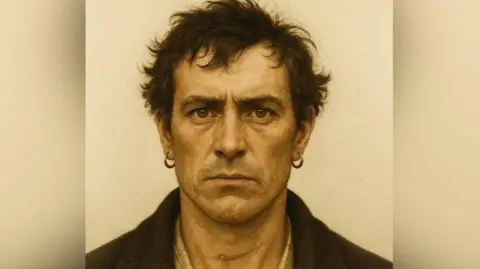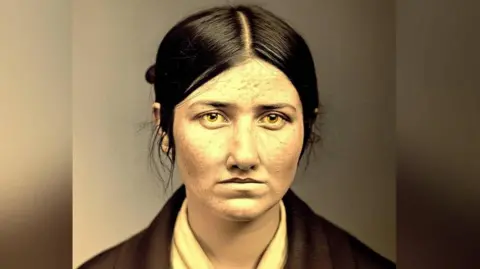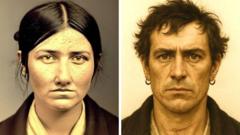Faces of Welsh convicts sent to Australia recreated by AI
 Unshackled/Roar Films
Unshackled/Roar FilmsArtificial Intelligence (AI) has helped researchers generate what they believe could have been the faces of Welsh convicts sent to Australia in the 19th Century.
The lives of 60 criminals transported from Anglesey for crimes as small as stealing a handkerchief have been traced by a team of volunteers and researchers.
They have used detailed prisoner records from the time, historical sketches and, where possible, photos of the prisoners' modern day descendants to create a profile of what they may have looked like.
Most convicts had been found guilty of theft, with many being repeat offenders, but some were transported for crimes as petty as trampling on the turnips of the local aristocracy.
An estimated 162,000 convicts were sent to Australia, at least 1,000 of which were Welsh.
They included John Frost, one of the leaders of the Chartist movement and the Newport Rising, who was initially sentenced to death before his sentence was reduced to transportation to Van Diemen's Land, as Tasmania was then called.
Roger Vincent has been a volunteer guide at Beaumaris Gaol on Anglesey for a number of years. The jail was in operation for just under 50 years in the 1800s, its 31 cells housing both men and women - separated - in total silence. Any talking was met with solitary confinement.
After a holiday to Australia, Mr Vincent began wondering about the historical connections between the two countries.
"I was amazed how many people had been transported to Australia, so I started concentrating on that and I found 60 Anglesey islanders that were transported to Australia over a relatively short period," he said.

Mr Vincent spent hours searching through the archives in Llangefni, Anglesey, to trace the lives of those transported and found that some of the crimes committed, and sentences given, were extremely harsh compared to today. They include:
- John Hughes, stole a handkerchief and glass, given 10 years - transported
- Hugh Hughes, stole five sheep, life sentence - transported
- William Williams, stole 29 shillings from a boy, seven years - transported
There were three reasons for transportation - prisons in the UK and Ireland were overcrowded, it was expensive to keep people in jails, and bodies were needed for manual labour work in Australia.
An estimated 20% of all Australians are descendants of convicts, while in Tasmania that figure is closer to 70%.
Prof Hamish Maxwell-Stewart, an academic specialising in convict life in Australia, said it used to be considered a "badge of shame" that Australia's origins "as a settler society were based on criminal transportation".
"But now, increasingly - and I think especially Tasmanians - are proud that they've had a convict in the past," he said.
Prof Maxwell-Stuart's work has led to the creation of what was recently Tasmania's number one listed experience on Tripadvisor, the Unshackled memorial of convicts in Hobart, the state capital.
 Unshackled/Roar Films
Unshackled/Roar FilmsDue to the distance, many convicts never returned home, staying in Australia to forge new lives, including starting families.
Caterina Giannetti now lives in Sydney, and is the direct descendant of Ann Williams who was transported from north Wales to Hobart in 1842 after being sentenced to 10 years for stealing.
"It's really fascinating to know where you've come from, if there are any family traits or abilities to find out when they started. It's very exciting to find out where your origins lay.
"And of course it's almost a badge of honour for an Australian to have a convict in their line."


